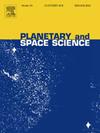撞击熔融角砾岩中具有组成对比的熔融域的冲击岩屑——来自印度达拉撞击构造的第一份报告
IF 1.7
4区 物理与天体物理
Q3 ASTRONOMY & ASTROPHYSICS
引用次数: 0
摘要
火流星撞击与巨大的动能有关,这些动能在行星表面转化为巨大的冲击压力(~ 100 GPa)和温度(高达20,000°C)。这些极端条件导致了独特的冲击特征,这些特征通常被用作诊断证据,以确认一个结构的陨石撞击起源。各种矿物中出现偏射玻璃伪晶是冲击变质作用的明确证据之一。同样,岩石完全熔化需要超过60gpa的压力;然而,熔融过程没有得到很好的约束,仍然是模糊的。目前的研究主要集中在印度达拉构造的冲击熔融角砾岩样品中的石英长石岩屑的冲击诱导熔融。在岩屑中观察到多个长石熔体条纹和一个类似于光长石的硅熔体透镜,显示出钾长石与二氧化硅的线性混合趋势。石英、熔体碎屑、球粒的平面变形特征及钴矿的痕迹显示了冲击变质的特征。通过拉曼光谱验证了硅熔体在冲击压力释放过程中形成的硅矿(一种高压硅多晶)的存在。长硅熔体串的组成似乎模拟了类似于合成K2O-Al2O3-SiO2体系的共晶熔化,表明共晶间断熔化的主导作用,而不是瞬时熔化行为。这种模式与在世界各地的撞击中经常报道的立即、广泛的融化形成对比。本文章由计算机程序翻译,如有差异,请以英文原文为准。
A shocked lithic clast with compositionally contrasting melt domains in the impact melt breccia-a first report from the Dhala impact structure, India
Bolide impacts are associated with enormous amount of kinetic energy which transforms into humongous shock pressures (∼100 GPa) and temperatures (up to 20,000 °C) on the planetary surfaces. These extreme conditions result in unique shock features that are routinely used as diagnostic evidence to confirm the meteorite impact origin of a structure. Occurrence of diaplectic glass pseudomorphing various minerals is one of the unequivocal evidences of shock metamorphism. Similarly, complete rock melting requires pressure in the excess of 60 GPa; however, the melting processes are not well constrained and remain ambiguous. The present study focuses on shock-induced melting of a quartzo-feldspathic lithic clast within an impact melt breccia sample from the Dhala structure, India. Multiple felsic melt stringers and a silicic melt (similar to lechatelierite) lense were observed across the clast, displaying a linear mixing trend between K-feldspar and silica. The occurrences of planar deformation features in quartz, melt clasts, spherules, and traces of coesite indicate characteristics of shock metamorphism. The presence of coesite (a high-pressure silica polymorph), formed during shock pressure release from the silica melt, was verified through Raman spectroscopy. Compositions of felsic melt stringers seem to mimic eutectic melting similar to a synthetic K2O-Al2O3-SiO2 system suggesting the dominant role of eutectic type punctuated melting rather than instantaneous melt behaviour. This pattern contrasts with an immediate, widespread melting often reported in impactites worldwide.
求助全文
通过发布文献求助,成功后即可免费获取论文全文。
去求助
来源期刊

Planetary and Space Science
地学天文-天文与天体物理
CiteScore
5.40
自引率
4.20%
发文量
126
审稿时长
15 weeks
期刊介绍:
Planetary and Space Science publishes original articles as well as short communications (letters). Ground-based and space-borne instrumentation and laboratory simulation of solar system processes are included. The following fields of planetary and solar system research are covered:
• Celestial mechanics, including dynamical evolution of the solar system, gravitational captures and resonances, relativistic effects, tracking and dynamics
• Cosmochemistry and origin, including all aspects of the formation and initial physical and chemical evolution of the solar system
• Terrestrial planets and satellites, including the physics of the interiors, geology and morphology of the surfaces, tectonics, mineralogy and dating
• Outer planets and satellites, including formation and evolution, remote sensing at all wavelengths and in situ measurements
• Planetary atmospheres, including formation and evolution, circulation and meteorology, boundary layers, remote sensing and laboratory simulation
• Planetary magnetospheres and ionospheres, including origin of magnetic fields, magnetospheric plasma and radiation belts, and their interaction with the sun, the solar wind and satellites
• Small bodies, dust and rings, including asteroids, comets and zodiacal light and their interaction with the solar radiation and the solar wind
• Exobiology, including origin of life, detection of planetary ecosystems and pre-biological phenomena in the solar system and laboratory simulations
• Extrasolar systems, including the detection and/or the detectability of exoplanets and planetary systems, their formation and evolution, the physical and chemical properties of the exoplanets
• History of planetary and space research
 求助内容:
求助内容: 应助结果提醒方式:
应助结果提醒方式:


